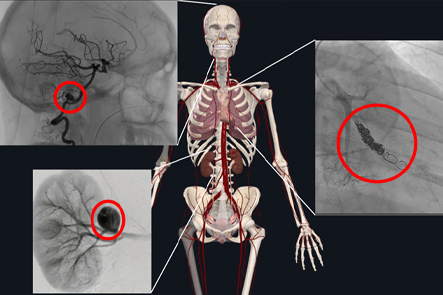Summary
The Embolic Filament is a novel endovascular wire that can more aptly fill a space in a blood vessel or aneurysm.
Inventors
What is it? What does it do?
When a blood vessel has a weak wall or abnormal characteristics, it has a higher likelihood of forming an aneurysm, or a bulge in the wall of an artery. Timing is critical in these situations to prevent abnormal blood vessels from forming an aneurysm, which could then rupture. One method of preventing ruptures or other hemorrhagic events is packing the blood vessel with an endovascular coil.
Currently, endovascular coils are manufactured by shaping a biocompatible wire into a coil using a mandrel. It can then be inserted into an aneurysm into a variety of pre-shaped 3D packing configurations. One of the main drawbacks to endovascular coils is the unintended unraveling of the main coil due to variable stiffness. This can make repositioning challenging, consequently increasing the likelihood of thromboembolic complications.
The Embolic Filament (EF) represents a transformation in the treatment of abnormal blood vessels. The simplified manufacturing process eliminates historical points of failure experienced with coils while simultaneously improving packing attenuation and deliverability to the point of interest.
Why is it better?
-
The efficient manufacturing process saves time and money during production.
-
Its precise 3D packing configurations can be designed to occlude different diameters and shapes. The flexible characteristics and design of the EF permits manufacturers to use mathematical modeling to create pre-shaped, optimal 3D packing configurations that cannot be achieved using current coil technology.
-
Its customizable detachment is tailored to the space being filled. A custom microcatheter using thermal or electrolytic heat at the distal end enables the EF to be detached at the desired length during the procedure eliminating the need for multiple coils or repositioning.
What is its current status?
After reviewing the patent and market landscape, MedStar Inventor Services first worked with Dr. Mai to file a provisional patent application covering the Embolic Filament to protect Dr. Mai’s invention for one year.
The MedStar Inventor Services team is now seeking a licensing/collaboration partner to help advance and commercialize this technology. Please contact us at invent@medstar.net.
Related invention:











